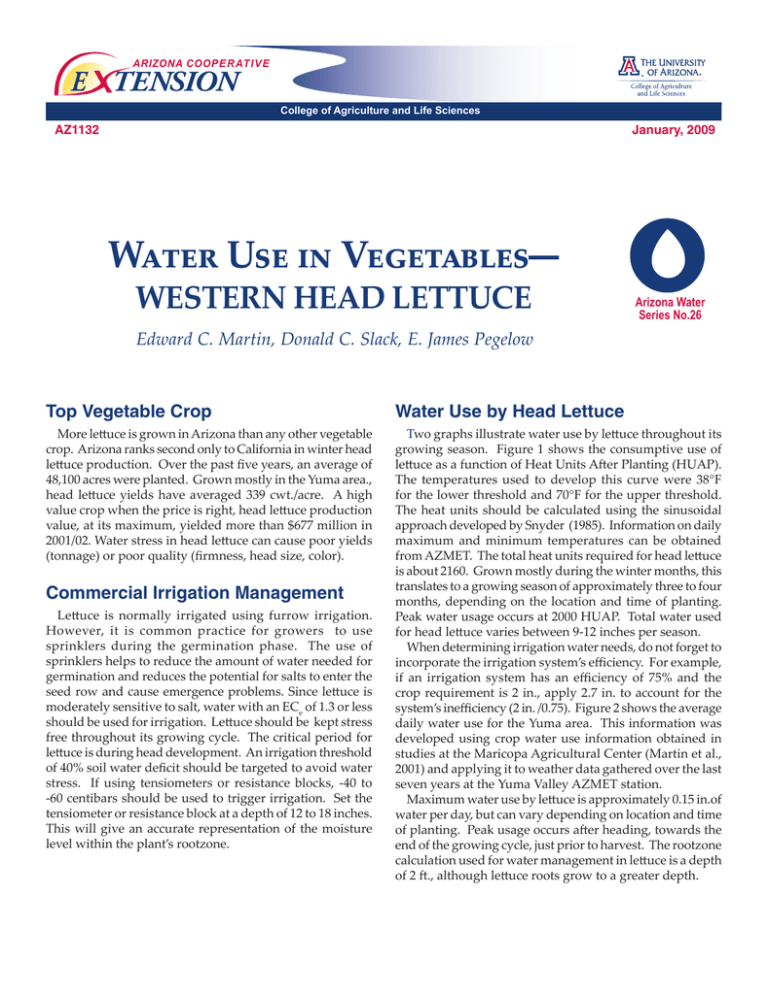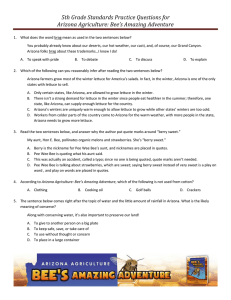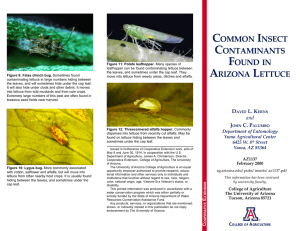Water Use in Vegetables— WESTERN HEAD LETTUCE E TENSION
advertisement

ARIZONA COOP E R AT I V E E TENSION College of Agriculture and Life Sciences AZ1132 January, 2009 Water Use in Vegetables— WESTERN HEAD LETTUCE Arizona Water Series No.26 Edward C. Martin, Donald C. Slack, E. James Pegelow Top Vegetable Crop Water Use by Head Lettuce More lettuce is grown in Arizona than any other vegetable crop. Arizona ranks second only to California in winter head lettuce production. Over the past five years, an average of 48,100 acres were planted. Grown mostly in the Yuma area., head lettuce yields have averaged 339 cwt./acre. A high value crop when the price is right, head lettuce production value, at its maximum, yielded more than $677 million in 2001/02. Water stress in head lettuce can cause poor yields (tonnage) or poor quality (firmness, head size, color). Two graphs illustrate water use by lettuce throughout its growing season. Figure 1 shows the consumptive use of lettuce as a function of Heat Units After Planting (HUAP). The temperatures used to develop this curve were 38°F for the lower threshold and 70°F for the upper threshold. The heat units should be calculated using the sinusoidal approach developed by Snyder (1985). Information on daily maximum and minimum temperatures can be obtained from AZMET. The total heat units required for head lettuce is about 2160. Grown mostly during the winter months, this translates to a growing season of approximately three to four months, depending on the location and time of planting. Peak water usage occurs at 2000 HUAP. Total water used for head lettuce varies between 9-12 inches per season. When determining irrigation water needs, do not forget to incorporate the irrigation system’s efficiency. For example, if an irrigation system has an efficiency of 75% and the crop requirement is 2 in., apply 2.7 in. to account for the system’s inefficiency (2 in. /0.75). Figure 2 shows the average daily water use for the Yuma area. This information was developed using crop water use information obtained in studies at the Maricopa Agricultural Center (Martin et al., 2001) and applying it to weather data gathered over the last seven years at the Yuma Valley AZMET station. Maximum water use by lettuce is approximately 0.15 in.of water per day, but can vary depending on location and time of planting. Peak usage occurs after heading, towards the end of the growing cycle, just prior to harvest. The rootzone calculation used for water management in lettuce is a depth of 2 ft., although lettuce roots grow to a greater depth. Commercial Irrigation Management Lettuce is normally irrigated using furrow irrigation. However, it is common practice for growers to use sprinklers during the germination phase. The use of sprinklers helps to reduce the amount of water needed for germination and reduces the potential for salts to enter the seed row and cause emergence problems. Since lettuce is moderately sensitive to salt, water with an ECe of 1.3 or less should be used for irrigation. Lettuce should be kept stress free throughout its growing cycle. The critical period for lettuce is during head development. An irrigation threshold of 40% soil water deficit should be targeted to avoid water stress. If using tensiometers or resistance blocks, -40 to -60 centibars should be used to trigger irrigation. Set the tensiometer or resistance block at a depth of 12 to 18 inches. This will give an accurate representation of the moisture level within the plant’s rootzone. References AZMET, Arizona Meteorological Network on the web at http://ag.arizona.edu/azmet/ Martin, E.C., A.S. de Oliveira, A.D. Folta, E.J. Pegelow and D.C. Slack. 2001. Development and testing of a small weighing lysimeter system to assess water use in shallow rooted crops. Transactions of the ASAE. 44(1):71-78. Snyder, R.L. 1985. Hand calculating degree days. Agric. Forest Meteorol., 35: 353-358 For additional information, contact your local Cooperative Extension office. Figure 1. Average daily water based on Heat Units After Planting (HUAP) for western head lettuce for a September 15th planting date. Any products, services or organizations that are mentioned, shown or indirectly implied in this publication do not imply endorsement by The University of Arizona. ARIZONA COOP E R AT I V E E TENSION THE UNIVERSITY OF ARIZONA COLLEGE OF AGRICULTURE AND LIFE SCIENCES The University of Arizona College of Agriculture and Life Sciences Tucson, Arizona 85721 Edward C. Martin, Ph.D. Extension Irrigation Specialist Donald C. Slack, Ph.D. Department Head E. James Pegelow, Ph. D. Senior Research Specialist Contact: Edward C. Martin edmartin@cals.arizona.edu Figure 2. Average daily water use for western head lettuce utilizing a calendar schedule for a September 15th planting date This information has been reviewed by University faculty. cals.arizona.edu/pubs/water/az1132.pdf Issued in furtherance of Cooperative Extension work, acts of May 8 and June 30, 1914, in cooperation with the U.S. Department of Agriculture, James A. Christenson, Director, Cooperative Extension, College of Agriculture & Life Sciences, The University of Arizona. The University of Arizona is an equal opportunity, affirmative action institution. The University does not discriminate on the basis of race, color, religion, sex, national origin, age, disability, veteran status, or sexual orientation in its programs and activities. 2 The University of Arizona Cooperative Extension





